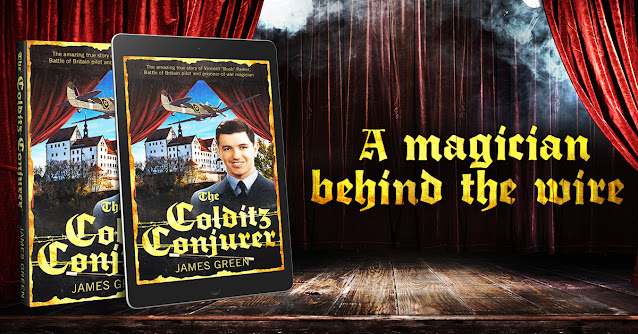Even more WW2-themed magic tricks
Even more examples of war-themed tricks invented by magicians to keep their acts topical for audiences and capture the national mood during World War Two.
Electro and The Victory Stand
Electro was a popular magician’s trick during World War Two. The effect involving swallowing and reproducing small lit electric light bulbs. It was invented by a magician called Cyro, and first published in Eric C. Lewis’ Studies in Mystery (1941) with the title ‘Lighted Bulbs From Mouth’. Later, the effect was marketed by London-based magic dealer Lewis Davenports & Co. using the name Electro. It received rave reviews from their customers:
“Your Electro is the best effect for a good many years,” wrote Danilla in The Demon Telegraph magazine.
While Ravelle reported, “I used ‘Electro’ for the first time (publicly) at a troop show last Friday. It was a SMASH HIT, they wouldn’t stop applauding”.
Lewis took the effect one step further by adding a plywood stand with seven bulb holders on. As the lit bulbs were unscrewed from the stand, the lights went out. The bulbs were then swallowed one by one, as in the original effect. A piece of thin wire was also swallowed. The climax came when all seven lit bulbs were pulled out of the mouth, hanging on the wire. Magician Peter Waring developed this further for his stage presentation of Electro. He made a metal stand shaped like a ‘V’. Davenports arranged for the rights to manufacture and marketed this as the patriotically-named ‘Victory Stand’. They also sold a version of Lewis’ cheaper wooden stand.
Advert for The Victory Stand
(Source: Author, courtesy of The Magic Circle)
See another example of the Victory Stand on the Davenports Collection website.
A competing (stolen?) version of the effect, ‘Victory Light Bulbs’ was sold by the Abbott’s Magic Company in America.
Homemade magic tricks
New metal and wooden made magic props were rare during World War Two as these raw materials were increasingly rationed as the war went on. Magic distributor Max Holden reported in The Demon Telegraph, for example, that “All metal is banned to magic. Now tin comes under that heading and also three-ply veneer”. By late 1941, even before the U.S.A. entered the war, metal for magic props became hard to come by in America.
Many magicians were forced instead to make their own props from cardboard, offcuts of wood or scrap metal (e.g. tinned food cans), covering the devices with coloured paper or wallpaper.
Collection of World War Two parlour magic tricks
(Source: Potter & Potter / Author)
This collection of parlour tricks is notable as an example of homemade World War Two-era magic. It includes classic effects such as a Sliding Die Box, Drawer Box with peaked roof, Card Rise Chest, Handkerchief Box, Silk Production Tube, Selbit’s Bricks, Die Cabinet, and other items.
Despite the unusual methods used to construct the tricks, they are generally constructed to a high standard.
Appearing Artillery Shell
The Appearing Artillery Shell is a simple trick which was likely homemade and not marketed for sale by magic dealers. The projectile’s body is made from a lathe-turned wooden fuse and metal tube, inserted within a metal cartridge (which may actually be a real spent artillery cartridge).
The size of the shell is broadly the size of those used in a British 25-pounder gun. The fuse and body collapse into the cartridge to reduce the space needed to conceal the shell before it is magically produced. The prop may be spring loaded.
This item is on display in The Magic Circle’s museum in London, donated by Derrick Speight MIMC.
R-A-F
Another popular trick of the era saw the magician tear three pieces of paper, coloured each red, white and blue, roll them into a ball and restore them in a single large Union flag. Some versions magically blended coloured silk handkerchiefs instead. This patriotic effect was typically the final trick in act. With the misdirection caused by the restoration, the trick was sometimes accompanied by the surprise production of a rabbit.
World War Two-themed paper tricks were popular during the war, as even though paper was rationed, magic dealer’s could get hold of supplies more easily than wood and metal. They ‘packed small, played big’ and were cheaper for magicians to buy than other types of parlour tricks.
The item below, also on display in The Magic Circle’s museum, is an example of this ‘blendo’-style torn and restored effect. In this trick, R-A-F stands for Really a Furore and the paper tear restoration results in a display of the circular segment of the Royal Air Force’s Ensign. The concentric circles design was commonly painted on UK aircraft to aid identification.
R-A-F
(Source: Author, courtesy of The Magic Circle)
Advert for the R-A-F paper tearing trick
(Source: Author's collection)
*** AVAILABLE NOW ***
Written by the Magic at War team, The Colditz Conjurer is a remarkable tale of perseverance, courage and cunning in the face of adversity. It features over 55 original photographs and maps. 129 pages.


.jpeg)




.jpeg)







Comments
Post a Comment